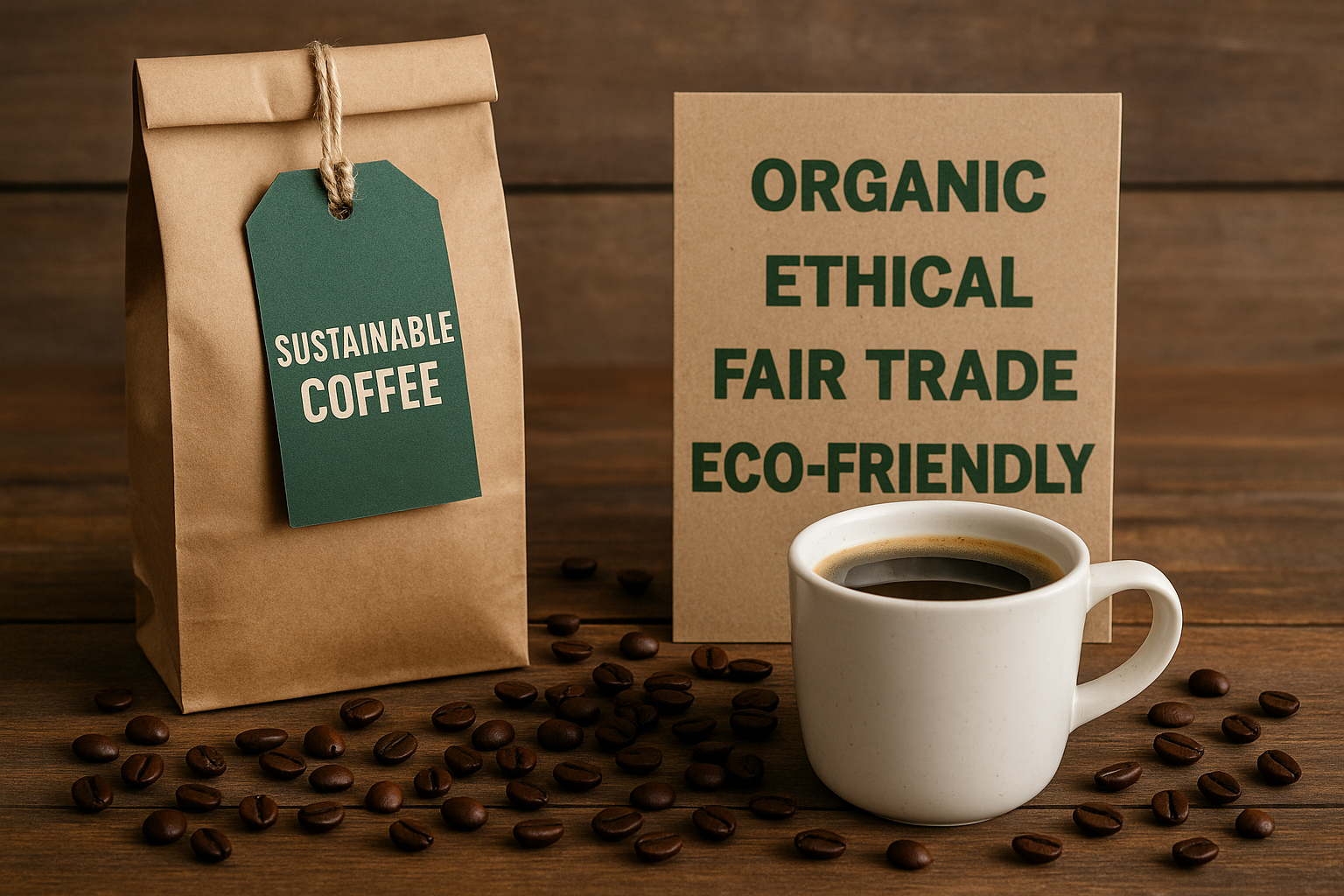Walk down any grocery store coffee aisle or scroll through online shops and you’ll see a flood of labels: “sustainable,” “eco-friendly,” “green-roasted,” “climate-positive.”
But how do you separate meaningful commitments from clever marketing? As demand for ethical and environmentally responsible coffee rises, so does the use of vague or misleading sustainability claims.
In this guide, we’ll break down what real sustainability looks like in the coffee industry, how to spot authentic brands, and what red flags to watch for.
Whether you’re a conscious consumer or a daily coffee drinker trying to do better, this article will equip you with the knowledge to make informed choices.
Why Sustainability in Coffee Matters
Coffee production affects people, land, water, wildlife, and the climate. As one of the most consumed beverages in the world, its environmental and social footprint is enormous.
Unsustainable coffee can lead to:
- Deforestation and habitat destruction
- Soil degradation and erosion
- Water contamination
- Low wages and labor exploitation
- Increased greenhouse gas emissions
Choosing truly sustainable coffee helps reduce these harms and supports long-term solutions in the supply chain.
What Real Sustainability in Coffee Looks Like
Not all sustainability claims are created equal. A truly sustainable coffee brand should address three pillars:
- Environmental Responsibility
- Social Equity and Fair Labor
- Economic Viability for Farmers
Let’s explore each.
Environmental Responsibility
Brands that take environmental sustainability seriously will:
- Support shade-grown and agroforestry methods
- Avoid synthetic pesticides and fertilizers
- Use organic or regenerative agriculture practices
- Focus on soil and water conservation
- Offset or reduce carbon emissions during roasting and transport
- Minimize plastic packaging or offer recyclable/compostable options
These efforts preserve ecosystems, reduce pollution, and help coffee farms adapt to climate change.
Social Equity and Fair Labor
Coffee brands with strong social commitments will:
- Source from cooperatives or direct trade relationships
- Pay above-market prices or Fair Trade premiums
- Support safe working conditions and equal opportunities
- Fund education, healthcare, or housing for farming communities
- Work to prevent child labor and gender-based discrimination
It’s not truly sustainable if the people growing the coffee can’t thrive.
Economic Viability for Farmers
Truly sustainable brands ensure that farmers:
- Have a stable income
- Receive training and technical support
- Are included in decision-making
- Can plan for the future without depending on short-term yields
This long-term view is key to ending the boom-and-bust cycle that traps many producers in poverty.
Certifications That Actually Mean Something
Look for third-party certifications that verify sustainable practices. The most respected include:
- Fair Trade Certified – Ensures fair prices, safe conditions, and community development.
- Rainforest Alliance – Focuses on environmental protection, social equity, and farm productivity.
- USDA Organic – No synthetic chemicals, GMOs, or harmful farming practices.
- Bird-Friendly (Smithsonian) – Requires organic and shade-grown methods to protect biodiversity.
- Carbon Neutral / Climate Neutral – Indicates efforts to reduce or offset greenhouse gas emissions.
While certifications aren’t perfect, they offer a verified baseline and often require regular audits.
Questions to Ask Before Buying
Here are some smart questions to help you identify truly sustainable coffee brands:
- Where was the coffee grown, and at what altitude?
- Is the coffee certified by any third-party programs?
- Does the company publish sustainability reports?
- Are the farmers paid fairly or part of cooperatives?
- How is the coffee packaged—recyclable, compostable, plastic-free?
- Does the brand offset its carbon emissions?
- Is there transparency about who grows and processes the coffee?
If the brand can’t or won’t answer these questions, that’s a red flag.
Greenwashing: How to Spot Red Flags
“Greenwashing” is when companies make misleading or exaggerated sustainability claims to appear eco-friendly without taking real action. Watch out for:
- Vague terms: Words like “natural,” “ethical,” “eco-friendly,” or “sustainable” without explanation or certification.
- Overuse of symbols: Leaves, earth icons, or “green” colors used to imply responsibility without substance.
- Lack of transparency: No sourcing info, farmer details, or third-party verification.
- Unrealistic pricing: If coffee is very cheap, it’s unlikely to support sustainable practices.
A truly responsible company will be proud to show how their coffee is sourced, processed, and packaged.
Examples of Truly Sustainable Coffee Brands
Here are a few companies known for transparent and impactful sustainability initiatives (note: always check their current practices as policies can evolve):
- Equal Exchange (USA): Fair Trade and organic with strong producer partnerships.
- Café Orgánico Marcala (COMSA) (Honduras): A cooperative using organic and biodynamic farming.
- Counter Culture Coffee (USA): Publishes detailed sustainability reports and works directly with farms.
- Café Libertad (Germany): Sources from indigenous cooperatives and focuses on social justice.
- Birds & Beans (Canada): All Bird-Friendly certified and committed to biodiversity.
Local roasters can also be excellent choices—just make sure to ask the right questions.
Small Roasters and Uncertified Coffee: Can It Still Be Sustainable?
Yes. Not all sustainable coffee is certified. Certifications can be expensive, and some small producers follow ethical practices without formal labels.
In these cases, look for direct trade relationships and transparency. Many small roasters visit farms, pay premiums, and build long-term partnerships but can’t afford certification costs. They’ll often share these stories online or on packaging.
Transparency is key—if the brand tells you who they work with, how much they pay, and how they support farms, that’s a good sign.
Packaging Matters Too
Sustainability isn’t just about what’s inside the bag—it’s also about the bag itself.
Look for:
- Compostable or recyclable packaging
- Minimal plastic
- Bulk purchase options
- Refill or reuse programs
Even better: buy whole beans and store them in an airtight, reusable container at home.
Supporting Better Brands with Every Brew
Every time you buy coffee, you cast a vote for the kind of world you want. If enough consumers choose ethical, transparent, and eco-conscious brands, the industry will shift to meet that demand.
And remember: the most sustainable coffee is the one you finish. Reducing waste—whether that’s unused grounds or forgotten beans—is part of the solution too.
Final Thoughts: A Cup That Cares
Coffee can be more than a delicious drink. It can be a tool for environmental healing, social justice, and economic empowerment—if we choose wisely.
Spotting truly sustainable coffee brands takes a little effort, but the rewards are far-reaching. When you know where your coffee comes from, how it was grown, and who grew it, your cup takes on new meaning.
The next time you shop for coffee, don’t just look for flavor notes—look for values. Your brew has power. Use it well.

